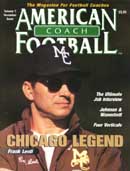AMERICAN FOOTBALL MONTHLY THE #1 RESOURCE FOR FOOTBALL COACHES
Article CategoriesAFM Magazine
|
Complete CoachBuilding Speed Agility & Quicknessby: Rod Smith © More from this issue The smallest edge on your competition can mean the difference between a championship and a season-ending loss. Complete Coach is an educational series helping coaches learn more about products and services dedicated to giving you the edge you need.
If the perfect football player were a recipe, the ingredients would be actually quite simple: strength, speed, agility and quickness. Stir with a healthy dash of mental capabilities, and you have an all-star in the making. Speed is often a byproduct of genetics; speed enhancement is not. Like strength conditioning, speed enhancement takes motivatio....The full article can only be seen by subscribers.
|
|
|||||||
| HOME |
MAGAZINE |
SUBSCRIBE | ONLINE COLUMNISTS | COACHING VIDEOS |
Copyright 2025, AmericanFootballMonthly.com
All Rights Reserved





